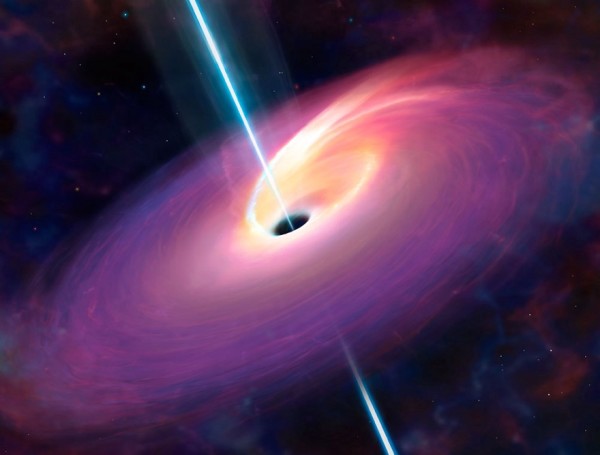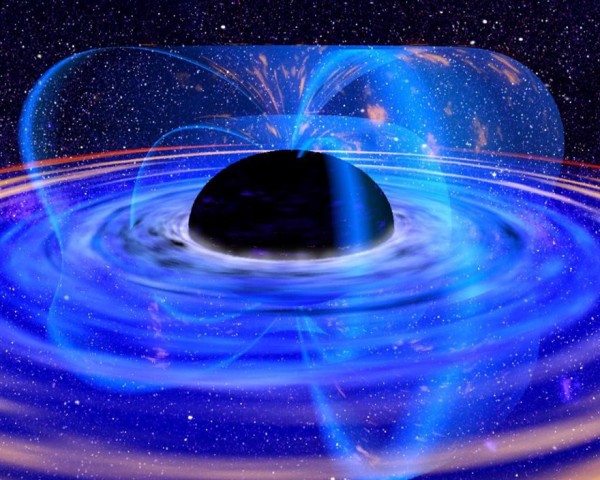“A single day is enough to make us a little larger or, another time, a little smaller.” -Paul Klee
When it comes to normal matter, dark matter is a bit of a puzzle. Other than through the gravitational force, there's no way we've yet figured out to make it interact. Try and collide it with matter and it passes right through; try and bombard it with energetic particles or radiation and it's completely transparent. But the story is quite different when it comes to dark matter and black holes.
While it won't make an accretion disk or "funnel" into the black hole, once it crosses the event horizon, it inevitably hurls towards the singularity, adding to the mass and angular momentum of the black hole. But beyond that, there's no way to know what went into your black hole, as what comes back out in the form of Hawking radiation will have no memory of how much dark matter vs. how much normal matter went into your black hole to begin with.
- Log in to post comments



“… what would be inside our sphere would be dominated by our Sun, and would weigh about 2 × 10^30 kg. On the other hand, the total amount of dark matter in that same sphere? Only about 1 × 10^19 kg, or just 0.0000000005% the mass of the normal matter in that same region…
the rate of black hole decay will finally surpass the rate of black hole growth. The Hawking radiation process results in the emission of particles and photons from outside the black hole’s event horizon, conserving all the energy, charge and angular momentum from the black hole’s insides. This process may take anywhere from [10000000000000000000000000000000000000000000000000000000000000000000] years (for a solar mass black hole) to [10000000000000000000000000000000000000000000000000000000000000000000000000000000000000000000000000000] years (for the most massive multi-billion solar mass black holes),
but eventually what comes out is a MIX OF EVERYTHING THAT’S POSSIBLE.”
Welcome to the SciFi Channel.
I see that S.N. is now down to utterly content-free trolling. It's a rare flash of wisdom, given how embarrassingly the other option has been faring.
Ethan,
One other thing.
About your
“If we drew a sphere that was 100 AU in radius (where one AU is the distance of the Earth from the Sun) around our Solar System, we’d enclose all the planets, moons, asteroids and pretty much the entire Kuiper belt, but the baryonic mass — the normal matter — of what would be inside our sphere would be dominated by our Sun, and would weigh about 2 × 10^30 kg. On the other hand, the total amount of dark matter in that same sphere? Only about 1 × 10^19 kg, or just 0.0000000005% the mass of the normal matter in that same region, or about the mass of a modest asteroid the size of Juno, approximately 200 km across” ….
I’d think that this would be yet another nail in the coffin for the universe’s homogeneity.
First of all, the supposed mix of dark matter vs. “normal” matter is un-homogeneous (25% vs. 5%).
Secondly, as you note above, despite dark matter representing 5 times the regular matter of the universe, in *our* solar system, dark matter represents only 0.0000000005% the mass of normal matter.
That is un-homogeneous to the very, very, very… high power.
@Ethan wrote
How is the inability to discern the electric charge of the matter that makes up a black hole reconciled with the jets emanating from the poles of feeding black holes? As I understand the theory, the particles in the jets are accelerated by the magnetic field of the black hole. The magnetic field should vary with the make-up of the black hole, no?
Ethan, as my favorite circus performer, I found a good song for you. A good picture, too:
I'm up on the tightwire
one side's ice and one is fire
it’s a circus game with you and me
I'm up on the tightrope
one side's hate and one is hope
but the tophat on my head is all you see
And the wire seems to be
the only place for me
a comedy of errors
and I'm falling
Like a rubber-neck giraffe
you look into my past
well maybe you're just to blind to - see
I'm up in the spotlight
ohh does it feel right
ohh the altitude
seems to get to me
I'm up on the tightwire
flanked by life and the funeral pyre
putting on a show
for you to see
Like a rubber-neck giraffe
you look into my past
well maybe you're just too blind to - see
I'm up in the spotlight
ohh does it feel right
ohh the altitude
really gets to get to me
I'm up on the tightwire
flanked by life and the funeral pyre
putting on a show for you to see.
https://www.youtube.com/watch?v=d2Z9qN8R9Bg
"Black holes tend to form in the innards of the galaxy"
Question, does the Galaxy (Chicken) come first or the Egg (Black Hole)?
And is this always the case?
I have always wondered which comes first.
There's something sadly fascinating about watching someone making a boasting ass of himself while arguing for geocentrism.
Thank You DR. Vera Rubin
I Have much more to learn about but she has contributed well
What happens to the magnetic moment when a BH forms?
Ragtag @6. The last I've heard its becoming accepted that the supermassive black holes were formed early one, more or less directly, and not from the merger of stellar mass black holes. Perhaps Ethan will enlighten us by letting us in on the current state of thinking about this?
There is no observation evidence to suggest the relationship of Dark Matter and black holes one way or another. What is the value of overselling the status of something like that to the general public, who very likely will spend the rest of their lives walking around thinking something is a fact cast in stone, when really it's a lot more likely a here today gone tomorrow throwaway.
@ #10 Chris:
I just read somewhere on the web that wimps annihilating themselves causing xxGeV amount of gamma ray burst of energy is being researched to see if more is spoted on the leading edge of black holes thus proving gravitational pull on dark matter.
In fact, I think it had to do with the term "Dark Mass" instead of "Dark Matter" as that was what the debate was over. I think it was on the cern web site, I was reading about but I closed out the tabs it was on so not sure.
Just to clarify what I thought I read which made sense. As a black hole spins, it's mass pulls in wimps and thus these collective wimps have more a chance of colliding with each other as they are pulled in towards the black holes center. As the black hole spins the angle or side at which you view it from shoud show more gamma ray burst from these colliding wimp particles.
@RM #11, #12: It took some searching, but the paper you saw a report about is http://arxiv.org/abs/1506.06728.
It came out in Ap. J. in June 2015, and refers (as you say in #12) the possibility that (a) a black hole can, because of its small radius, "concentrate" dark matter into a surrounding halo, (b) the Lense-Thirring effect from a spinning black hole could lead to an azimuthally varying density of that halo, and (c) if dark matter annihilates to gammas, this would lead to a spin-dependent asymmetry for such gamma emission.
"How is the inability to discern the electric charge of the matter that makes up a black hole reconciled with the jets emanating from the poles of feeding black holes? "
There's no problem at all. Those jets are from matter falling in and being ejected in collisions with other matter falling in and half losing energy (to fall further in) and half gaining energy (to stream out).
And, as the matter drops in and gain thermal properties in the hundreds of thousands of kelvin range, that heat will generate light in the XRay range.
In the accretion disk it is attenuated by matter, but directly out perpendicular to the disk, it's less optically dense and can leave.
Two mechanisms for jets.
Neither require anything coming out of the event horizon of a black hole.